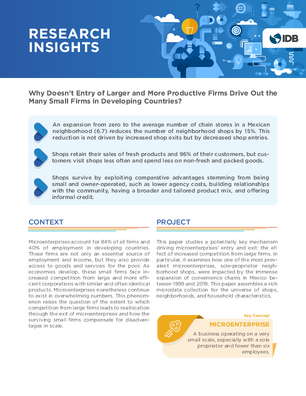Research Insights: Why Doesn't Entry of Larger and More Productive Firms Drive Out the Many Small Firms in Developing Countries?
Date
Sep 2023
An expansion from zero to the average number of chain stores in a Mexican neighborhood (6.7) reduces the number of neighborhood shops by 15%. This reduction is not driven by increased shop exits but by decreased shop entries. Shops retain their sales of fresh products and 96% of their customers, but customers visit shops less often and spend less on non-fresh and packed goods. Shops survive by exploiting comparative advantages stemming from being small and owner-operated, such as lower agency costs, building relationships with the community, having a broader and tailored product mix, and offering informal credit.




